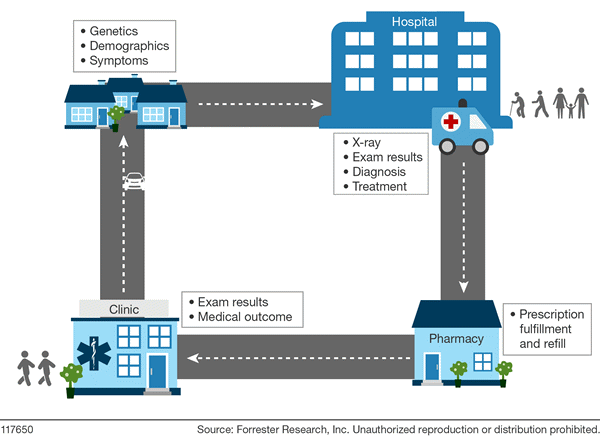Data Today Keeps The Doctor Away
 In scanning through my O’Reilly Data Newsletter today, I noticed A Healthy Dose of Data, an MIT Sloan case study on the data and analytics culture at Intermountain, a healthcare network that runs 22 hospitals and 185 clinics. The study is definitely worth the read. It reviews the history of data use at Intermountain, which began way before the “big data” craze of recent years. In fact, it was back in the 1950s that one of the Intermountain cardiologists, Homer Warner, began to explore clinical data to understand why some heart patients experienced better outcomes than others. He went on to become known as the “father of medical informatics – the use of computer programs to analyze patient data to determine treatment protocols,” and with colleagues designed and launched their first decision-support tool.
In scanning through my O’Reilly Data Newsletter today, I noticed A Healthy Dose of Data, an MIT Sloan case study on the data and analytics culture at Intermountain, a healthcare network that runs 22 hospitals and 185 clinics. The study is definitely worth the read. It reviews the history of data use at Intermountain, which began way before the “big data” craze of recent years. In fact, it was back in the 1950s that one of the Intermountain cardiologists, Homer Warner, began to explore clinical data to understand why some heart patients experienced better outcomes than others. He went on to become known as the “father of medical informatics – the use of computer programs to analyze patient data to determine treatment protocols,” and with colleagues designed and launched their first decision-support tool.
The case study goes on to describe how Intermountain has cultivated a strong data and analytics culture. Over time – Rome was not built in a day, as they say – they established data maturity across the organization by investing in the capacity (new tools and technologies), developing the competencies (new skills and processes) and finally spreading the culture (awareness, understanding and best practices) of data and analytics. Their analytical approach brought results – fewer surgical infections, more effective use of antibiotics, less time in intensive care etc – contributing to lower costs, better medical outcomes, and overall patient satisfaction.
While the use of data and analytics has spread across departments within Intermountain's hospitals, adoption of the new data culture is not compulsory across the broader network. Many of the doctors working with the Intermountain hospitals maintain independent medical practices. But in the interest of gently pressuring them to become more data-driven, Intermountain is launching a tool to provide their primary care physicians with the ability to evaluate specialists based on clinical outcomes, costs and patient satisfaction – before making a referral. That kind of transparency lets the data speak for itself.
 I found the case study particularly interesting because last quarter I wrote a case study on data sharing in healthcare which included Intermountain, Case Study: Data Sharing Improves Insights And Outcomes. ConvergeHealth, a health data sharing platform from Deloitte, provides tools and processes to facilitate access to and analysis of data from multiple healthcare sources. But the solution goes beyond the tools. It includes collaboration across a consortium of healthcare providers and payers – across the healthcare continuum – who make their data accessible to others. Intermountain was one of the first organizations to sign up. Their goal is not only to improve outcomes in their facilities and across their network of doctors but to allow others to benefit from their lessons learned and data collected.
I found the case study particularly interesting because last quarter I wrote a case study on data sharing in healthcare which included Intermountain, Case Study: Data Sharing Improves Insights And Outcomes. ConvergeHealth, a health data sharing platform from Deloitte, provides tools and processes to facilitate access to and analysis of data from multiple healthcare sources. But the solution goes beyond the tools. It includes collaboration across a consortium of healthcare providers and payers – across the healthcare continuum – who make their data accessible to others. Intermountain was one of the first organizations to sign up. Their goal is not only to improve outcomes in their facilities and across their network of doctors but to allow others to benefit from their lessons learned and data collected.
This new data culture, and data sharing culture, is the future of healthcare. It must be. According to a recent Organization for Economic Co-operation and Development report, the United States spends, on a per capita basis, more than twice the average spent by 34 industrialized nations on health care ($8,745 in 2012 compared to an average of $3,484), but gets health results towards the bottom of the pack.
Another interesting twist at Intermountain is that their Chief Data Officer, Lee Pierce, was only appointed in 2015, but had been a part of the business intelligence and analytics team for much longer. Clearly Intermountain was able to develop their data maturity initially without the role, but eventually decided to establish the leadership position. As Intermountain expands its data sharing and evangelism of the use of data, the CDO role becomes not only a driver for data maturity within the organization but also the face of it outside the organization.
An upcoming Forrester report explores the role of the CDO in developing data maturity and driving insights-driven transformations.